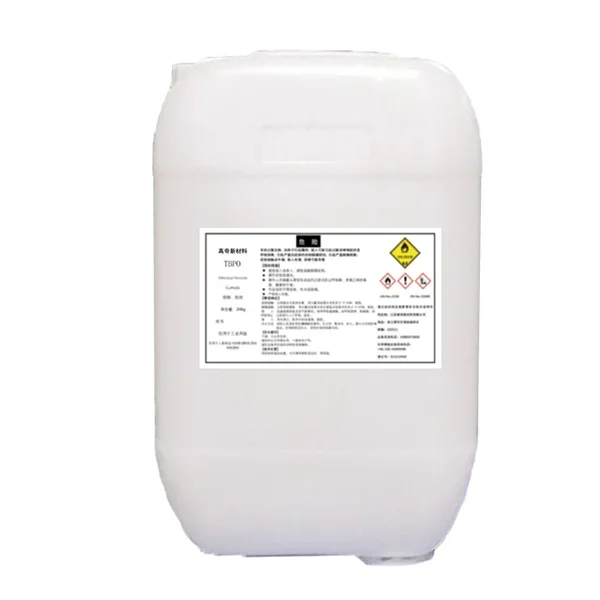Understanding Organic Peroxides: Essential Compounds in Polymer Chemistry
Organic peroxides are a fascinating class of compounds that play a crucial role in the field of polymer chemistry. These compounds, characterized by the presence of the peroxide functional group (R−O−O−R′), are widely used as initiators in various polymerization processes, making them essential for producing a range of materials, from plastics to resins. In this article, we will explore the properties, applications, and safety considerations of organic peroxides, with a focus on Hengqi's TBPMH, a high-performance organic peroxide that exemplifies the benefits of this important chemical class.

What Are Organic Peroxides?
Organic peroxides are organic compounds that contain a bivalent -O-O- structure, which is responsible for their unique chemical properties. When these compounds decompose, they release free radicals, which are highly reactive species that can initiate polymerization reactions. This ability to generate free radicals makes organic peroxides invaluable in the production of various polymers, including polyethylene, polystyrene, and acrylics.
Key Properties of Organic Peroxides
1. Thermal Stability: Organic peroxides vary in their thermal stability, which is critical for their application in polymerization. For instance, Hengqi's TBPMH has a self-accelerating decomposition temperature (SADT) of 55°C, indicating that it can be safely stored and used within specified temperature ranges.
2. Half-Life: The half-life of an organic peroxide is an important factor that influences its reactivity. For TBPMH, half-lives are measured at various temperatures, such as 0.1 hours at 135°C and 1 hour at 114°C. Understanding these values helps manufacturers determine the appropriate conditions for using these compounds.
3. Decomposition Products: When organic peroxides decompose, they produce various byproducts, including carbon dioxide and other organic compounds. The decomposition process must be carefully managed to avoid hazardous situations.
Applications of Organic Peroxides
Organic peroxides are used in a variety of applications, particularly in the polymer industry:
1. Polymerization Initiators: Organic peroxides like TBPMH are commonly used to initiate the polymerization of styrene and its copolymers, as well as acrylates and methacrylates. The polymerization temperature range for TBPMH is between 90°C and 175°C, making it versatile for different polymerization processes.
2. Curing Agents: TBPMH is also utilized as a curing agent for unsaturated polyester resins, particularly in hot compression molding processes. This application is crucial in producing fiberglass-reinforced plastics, which are widely used in automotive and construction industries.
3. Ethylene Polymerization: TBPMH serves as a polymerization initiator for low-density polyethylene (LDPE), with an initiating temperature range of 210°C to 270°C. This application is essential for producing various plastic products.
4. Cross-Linking Agents: Organic peroxides are used to cross-link polymers, enhancing their mechanical properties and thermal stability. This is particularly important in the production of rubber and elastomeric materials.
Safety Considerations
While organic peroxides are valuable in industrial applications, they also pose certain risks. Proper handling and storage are essential to ensure safety:
1. Storage Conditions: TBPMH should be stored in a cool, well-ventilated area, with a recommended maximum storage temperature of 25°C. The packaging must be tightly closed to prevent exposure to air and moisture.
2. Avoiding Contamination: It is crucial to keep organic peroxides away from reducing agents, acids, and heavy metals, as these substances can lead to dangerous reactions. Always refer to the Material Safety Data Sheet (MSDS) for specific handling instructions.
3. Fire Safety: Organic peroxides are classified as dangerous goods (UN number 3105, Class II). In case of a fire, small fires should be extinguished with dry powder or carbon dioxide fire extinguishers, while larger fires require significant amounts of water to prevent re-ignition.
Conclusion
Organic peroxides, such as Hengqi's TBPMH, are essential compounds in polymer chemistry, enabling the production of a wide range of materials through their ability to generate free radicals. Understanding their properties, applications, and safety considerations is crucial for manufacturers and users alike. By utilizing high-quality organic peroxides, industries can enhance their production processes and create innovative materials that meet the demands of modern applications.
For more information about Hengqi's organic peroxides and how they can benefit your production processes, please contact us today. Our commitment to quality and safety ensures that you receive the best products for your polymerization needs.



